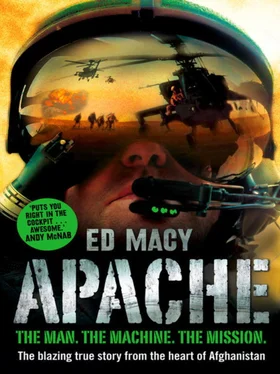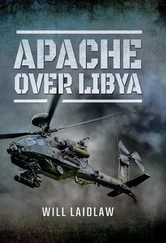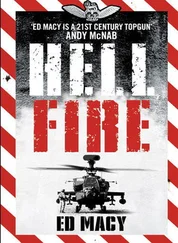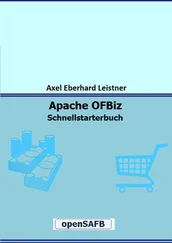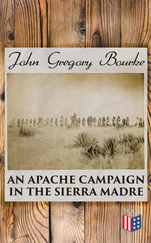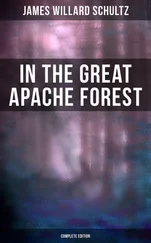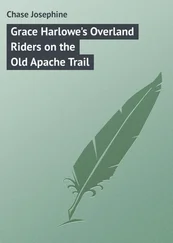Its angular shape wasn’t the Apache’s only stealth quality. It had four rotor blades rather than two, allowing it to turn at half the speed – five revolutions per second – and thus with half the noise to generate the same lift as the traditional two-bladed helicopters like the great thumping Hueys of the Vietnam War. Each blade’s high-tech design made the aircraft quieter still. Instead of hammering the air like the Chinook, Apache blades sliced through it, giving the gunship its trademark low-pitched growl.
It also gave off the lowest heat signature of any helicopter built. Though the engine burned fuel at 800 degrees celsius, a powerful cooling system meant you wouldn’t even burn your hand if you pressed it against the exhaust. That seriously hindered a heat-seeking missile’s ability to track it. To mask more heat, its skin was coated with special paint that reflected less light too.
When incoming fire did hit the Apache, its ingenious design meant it could withstand a remarkable amount of it – including a 23-mm high explosive round. A US Apache in Iraq even once took a direct hit from a shoulder-fired surface-to-air missile, shredding its starboard engine and wing and leaving its rotor blades in tatters. It still managed to return fire, kill its attackers and make it back to base.
What went on inside the aircraft was cleverer still. Thirteen kilometres of electric wiring linked the avionics, engines, visual aids and weapons systems run by a myriad of on-board computers which monitored every tiny electronic pulse.
Most impressive of all the Apache’s cutting edge technology was how it found its prey. Its Target Acquisition and Designation Sight system was made up of an array of cameras housed in a double-headed nose cone that looked like a pair of giant insect eyes. Its 127-times-magnification day TV camera could read a car number plate 4.2 kilometres away. At night, the thermal camera was so powerful it could identify a human form from a distance of four kilometres, and spots of blood on the ground from a kilometre up.
Then there was the Apache’s punch. The aircraft’s three weapons systems struck with varying degrees of power, speed and precision, depending on the desired target. The 30-mm M230 cannon under the Apache’s belly was best for individual targets, firing ten High Explosive Dual Purpose rounds a second to an accuracy of within three metres. Their armour-piercing tips made light work of Armoured Personnel Carriers, vehicles and buildings. Their bodies fragmented on impact just like a large grenade, throwing out hundreds of sharp red-hot pieces of metal. But duality came from the incendiary charge; once it had penetrated or fragged the target, it set it alight. The helicopter’s magazine packed up to 1,160 of them, fired in bursts of 10, 20, 50, 100 – or all at once.
Rockets were its optimum area weapon for hitting infantry, dismounted or in vehicles. A maximum of seventy-six could be loaded into up to four CRV7 rocket pods on the weapons pylons, hung from the stubby wings either side of the aircraft. There were two types of rockets: the Flechette, an anti-personnel / vehicle weapon, containing eighty five-inch-long Tungsten darts; and the HEISAP for buildings, vehicles or ships. Its kinetic penetrating head drove through up to half an inch of steel, and the body of the projectile contained an explosive zirconium incendiary that stuck to light alloys and combustibles, torching them.
Finally, thick-walled buildings and fast moving armour were taken out with our main anti-tank weapon, the Semi-Active Laser Hellfire II air-to-ground missile. Each Apache could carry up to sixteen of them, mounted on four rails under the wings. Laser guided from the cockpit for pinpoint accuracy, its 20-lb high explosive and dual shaped charge warhead packed a 5 million-lb-per-square-inch punch on impact – defeating all known armour.
The gunship first saw active service with the US Army during Operation Just Cause, the 1989 invasion of Panama, but it was during the first Gulf War that it really won its spurs. At 2:38am Baghdad time on 17 January 1991, eight AH64s fired the opening salvoes of the conflict. They destroyed an Iraqi radar site near the Iraqi–Saudi Arabian border.
The devastation they then wrought at Mutla Ridge reset the height of the bar. A fleet of Apaches – backed up by A10s – destroyed hundreds of Iraqi military vehicles fleeing Kuwait on the Basra road. The endless line of twisted and smouldering metal was nicknamed the Highway of Death. Their final tally for the war was 278 tanks, 180 artillery pieces and 500 Armoured Personnel Carriers.
In 1998, the AH64D came into service. It was even deadlier; 400 per cent more lethal (hitting more targets) and 720 per cent more survivable than its predecessor. The most significant addition was the state of the art Longbow Radar which could operate in all weathers, day or night, simultaneously detect 1,024 potential targets, moving or static, up to eight kilometres away, classify the top 256 and display the sixteen most threatening for destruction – all in three seconds. Twenty-five seconds later, every one of those targets could be destroyed by a single Apache’s Hellfires. A squadron of eight AH64Ds working in unison could terminate 128 tanks in twenty-eight seconds – just by raising one Apache Longbow Radar above the tree or ridge line for a few seconds. They christened it ‘Fire and Forget’.
Gradually, the US allowed its closest allies to purchase the Apache. Israel were the first, followed by the Netherlands, Saudi Arabia, Singapore, Egypt, Greece, Japan, Kuwait and the United Arab Emirates. In the late 1990s, the British government finally decided it needed them too. As a nation, we didn’t have an attack helicopter capability, just a few Lynx squadrons armed with a couple of TOW anti-tank missiles strapped onto the side of each craft.
Despite its cutting edge design and astonishingly powerful Longbow, the AH64D still had a few ongoing shortcomings. They couldn’t operate off ships, and they weren’t powerful enough to carry a significant amount of ammunition and fuel at the same time. To fly them at low level meant heavy anti-aircraft fire could still bring them down.
Our generals approached the government with an ambitious plan. Why didn’t we buy Boeing’s Apache shell, keep the good bits and make the rest even better ourselves? The boffins at Westland Helicopters went to work.
The most important change was two Rolls Royce RTM 322 engines. Each churned out more than twice the brake horsepower of a Formula One racing car, giving our model 30 per cent more power than the American AH64D. It allowed us to fly further, higher and fight with more weapons.
The Brits also scoured the globe for the best countermeasures and built them into the world’s most sophisticated defensive aide suite. It allowed pilots to take the aircraft above small arms range, which downed 95 per cent of all military helicopters, and into the previously lethal SAM belt – because the British Apache could now defeat surface-to-air missiles.
They also added a folding blade mechanism so we could operate off aircraft carriers in confined space; an automatic de-icer built into the blades so we could fight in the Arctic; Saturn radios so highly encrypted that their transmissions couldn’t be decoded by any intercept; new motors for the CRV7 rockets, making them faster and more accurate; and a unique health monitoring system which enabled the aircraft to automatically diagnose any problems through dozens of microscopic sensors.
The UK bought sixty-seven of Westland’s finished article for a cool £46 million each – making the Apache AH Mk1 the second most expensive British aircraft ever made, behind the £62-million Eurofighter Typhoon. The whole Apache project set the MoD back £4.13 billion.
Читать дальше
Конец ознакомительного отрывка
Купить книгу
